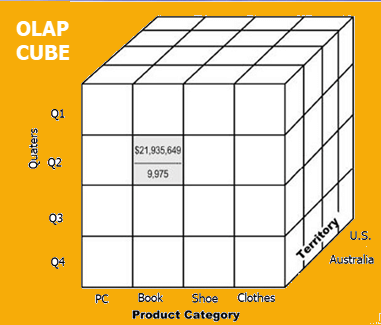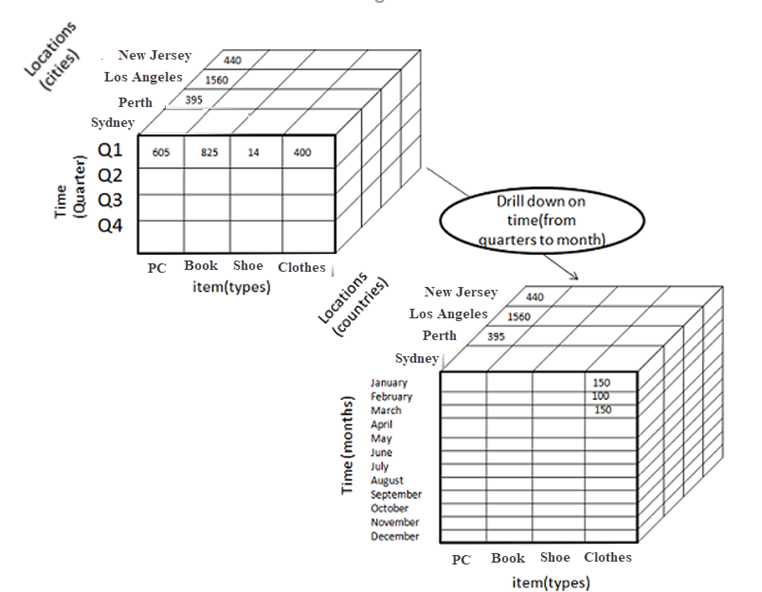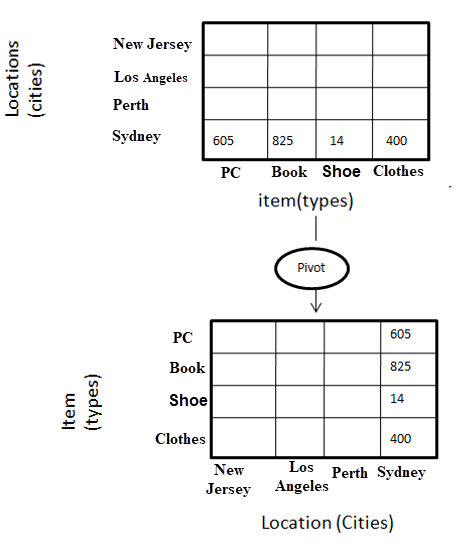What is OLAP (Online Analytical Processing): Cube, Operations & Types
What is Online Analytical Processing?
OLAP is a category of software that allows users to analyze information from multiple database systems at the same time. It is a technology that enables analysts to extract and view business data from different points of view. OLAP stands for Online Analytical Processing.
Analysts frequently need to group, aggregate and join data. These operations in relational databases are resource intensive. With OLAP data can be pre-calculated and pre-aggregated, making analysis faster.
OLAP databases are divided into one or more cubes. The cubes are designed in such a way that creating and viewing reports become easy.
In this tutorial, you will learn-
- What is Online Analytical Processing?
- OLAP cube
- Basic analytical operations of OLAP
- Types of OLAP systems
- ROLAP
- MOLAP
- Hybrid OLAP
- Advantages of OLAP
- Disadvantages of OLAP
OLAP cube:
At the core of the OLAP, concept is an OLAP Cube. The OLAP cube is a data structure optimized for very quick data analysis.
The OLAP Cube consists of numeric facts called measures which are categorized by dimensions. OLAP Cube is also called the hypercube.
Usually, data operations and analysis are performed using the simple spreadsheet, where data values are arranged in row and column format. This is ideal for two-dimensional data. However, OLAP contains multidimensional data, with data usually obtained from a different and unrelated source. Using a spreadsheet is not an optimal option. The cube can store and analyze multidimensional data in a logical and orderly manner.
How does it work?
A Data warehouse would extract information from multiple data sources and formats like text files, excel sheet, multimedia files, etc.
The extracted data is cleaned and transformed. Data is loaded into an OLAP server (or OLAP cube) where information is pre-calculated in advance for further analysis.
Basic analytical operations of OLAP
Four types of analytical operations in OLAP are:
- Roll-up
- Drill-down
- Slice and dice
- Pivot (rotate)
1) Roll-up:
Roll-up is also known as "consolidation" or "aggregation." The Roll-up operation can be performed in 2 ways
- Reducing dimensions
- Climbing up concept hierarchy. Concept hierarchy is a system of grouping things based on their order or level.
Consider the following diagram
- In this example, cities New jersey and Lost Angles and rolled up into country USA
- The sales figure of New Jersey and Los Angeles are 440 and 1560 respectively. They become 2000 after roll-up
- In this aggregation process, data is location hierarchy moves up from city to the country.
- In the roll-up process at least one or more dimensions need to be removed. In this example, Quater dimension is removed.
2) Drill-down
In drill-down data is fragmented into smaller parts. It is the opposite of the rollup process. It can be done via
- Moving down the concept hierarchy
- Increasing a dimension
Consider the diagram above
- Quater Q1 is drilled down to months January, February, and March. Corresponding sales are also registers.
- In this example, dimension months are added.
3) Slice:
Here, one dimension is selected, and a new sub-cube is created.
Following diagram explain how slice operation performed:
- Dimension Time is Sliced with Q1 as the filter.
- A new cube is created altogether.
Dice:
This operation is similar to a slice. The difference in dice is you select 2 or more dimensions that result in the creation of a sub-cube.
4) Pivot
In Pivot, you rotate the data axes to provide a substitute presentation of data.
In the following example, the pivot is based on item types.
Types of OLAP systems
OLAP Hierarchical Structure
| Type of OLAP | Explanation |
| Relational OLAP(ROLAP): | ROLAP is an extended RDBMS along with multidimensional data mapping to perform the standard relational operation. |
| Multidimensional OLAP (MOLAP) | MOLAP Implementes operation in multidimensional data. |
| Hybrid OnlineAnalytical Processing (HOLAP) | In HOLAP approach the aggregated totals are stored in a multidimensional database while the detailed data is stored in the relational database. This offers both data efficiency of the ROLAP model and the performance of the MOLAP model. |
| Desktop OLAP (DOLAP) | In Desktop OLAP, a user downloads a part of the data from the database locally, or on their desktop and analyze it. DOLAP is relatively cheaper to deploy as it offers very few functionalities compares to other OLAP systems. |
| Web OLAP (WOLAP) | Web OLAP which is OLAP system accessible via the web browser. WOLAP is a three-tiered architecture. It consists of three components: client, middleware, and a database server. |
| Mobile OLAP: | Mobile OLAP helps users to access and analyze OLAP data using their mobile devices |
| Spatial OLAP : | SOLAP is created to facilitate management of both spatial and non-spatial data in a Geographic Information system (GIS) |
ROLAP
ROLAP works with data that exist in a relational database. Facts and dimension tables are stored as relational tables. It also allows multidimensional analysis of data and is the fastest growing OLAP.
Advantages of ROLAP model:
- High data efficiency. It offers high data efficiency because query performance and access language are optimized particularly for the multidimensional data analysis.
- Scalability. This type of OLAP system offers scalability for managing large volumes of data, and even when the data is steadily increasing.
Drawbacks of ROLAP model:
- Demand for higher resources: ROLAP needs high utilization of manpower, software, and hardware resources.
- Aggregately data limitations. ROLAP tools use SQL for all calculation of aggregate data. However, there are no set limits to the for handling computations.
- Slow query performance. Query performance in this model is slow when compared with MOLAP
MOLAP
MOLAP uses array-based multidimensional storage engines to display multidimensional views of data. Basically, they use an OLAP cube.
Learn more about OLAP here
Hybrid OLAP
Hybrid OLAP is a mixture of both ROLAP and MOLAP. It offers fast computation of MOLAP and higher scalability of ROLAP. HOLAP uses two databases.
- Aggregated or computed data is stored in a multidimensional OLAP cube
- Detailed information is stored in a relational database.
Benefits of Hybrid OLAP:
- This kind of OLAP helps to economize the disk space, and it also remains compact which helps to avoid issues related to access speed and convenience.
- Hybrid HOLAP's uses cube technology which allows faster performance for all types of data.
- ROLAP are instantly updated and HOLAP users have access to this real-time instantly updated data. MOLAP brings cleaning and conversion of data thereby improving data relevance. This brings best of both worlds.
Drawbacks of Hybrid OLAP:
- Greater complexity level: The major drawback in HOLAP systems is that it supports both ROLAP and MOLAP tools and applications. Thus, it is very complicated.
- Potential overlaps: There are higher chances of overlapping especially into their functionalities.
Advantages of OLAP
- OLAP is a platform for all type of business includes planning, budgeting, reporting, and analysis.
- Information and calculations are consistent in an OLAP cube. This is a crucial benefit.
- Quickly create and analyze "What if" scenarios
- Easily search OLAP database for broad or specific terms.
- OLAP provides the building blocks for business modeling tools, Data mining tools, performance reporting tools.
- Allows users to do slice and dice cube data all by various dimensions, measures, and filters.
- It is good for analyzing time series.
- Finding some clusters and outliers is easy with OLAP.
- It is a powerful visualization online analytical process system which provides faster response times
Disadvantages of OLAP
- OLAP requires organizing data into a star or snowflake schema. These schemas are complicated to implement and administer
- You cannot have large number of dimensions in a single OLAP cube
- Transactional data cannot be accessed with OLAP system.
- Any modification in an OLAP cube needs a full update of the cube. This is a time-consuming process
Summary:
- OLAP is a technology that enables analysts to extract and view business data from different points of view.
- At the core of the OLAP, the concept is an OLAP Cube.
- Various business applications and other data operations require the use of OLAP Cube.
- There are primary five types of analytical operations in OLAP 1) Roll-up 2) Drill-down 3) Slice 4) Dice and 5) Pivot
- Three types of widely used OLAP systems are MOLAP, ROLAP, and Hybrid OLAP.
- Desktop OLAP, Web OLAP, and Mobile OLAP are some other types of OLAP systems.







Comments
Post a Comment